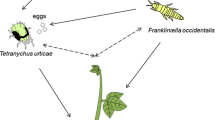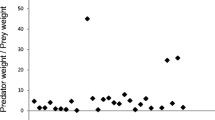Summary
Scorpions, spiders and solpugids are generalist predators on the same types of arthropod prey. However, these potential competitors also frequently eat one another (=intraguild predation). In a 29 mo. experiment, >6,000 scorpions were removed from 300 (10x10m) quadrats. Significantly more spiders (but not solpugids) occurred in removal versus control quadrats. Two alternate hypotheses potentially explain this result: exploitation competition for jointly exploited prey or intraguild predation. There was no evidence of exploitation competition: no differences existed between removal and control quadrats in prey abundance or spider size and reproductive characteristics. It appears that the release from predation pressure in areas from which scorpions were removed produced the observed increase in spider abundance. Current ecological theory does not fully apply to situations whereby species at the same trophic level interact as both predators and potential competitors.
Similar content being viewed by others
References
Abraham BJ (1983) Spatial and temporal patterns in a sagebrush steppe spider community (Arachnida: Araneae). Journal of Arachnology 11:31–50
Allred DM and Kaston BJ (1983) A list of Utah spiders with their localities. Great Basin Naturalist 43:494–522
Bender EA, Case TJ, Gilpin ME (1984) Pertubation experiments in community ecology: Theory and practice. Ecology 65:1–13
Brown JH, Davidson D, Reichman O (1979) An experimental study of competition between seed eating desert rodents and ants. Amer Zool 19:1129–1143
Chew M (1961) Ecology of the spiders of a desert community. New York Entomological Society 69:5–41
Cloudsley-Thompson JL (1958) Spiders, scorpions, centipedes and mites. Pergamon Press Ltd, Oxford
Cloudsley-Thompson JL (1977) Adaptational biology of solifugae (Solpugida). Bull British Arachnol Soc 4:61–71
Connell JH (1983) On the prevelence and relative importance of interspecific competition: Evidence from field experiments. Amer Natur 122:661–696
Crawford CS (1981) Biology of desert invertebrates. Springer-Verlag, New York, NY
Foelix RF (1982) The biology of spiders. Harvard University Press, Cambridge, Massachusetts
Gertsch WJ, Reichert SE (1976) The spacial and temporal partitioning of a desert spider community, with description of new species. Amer Mus Novit 2604:1–25
Holt RD (1984) Spatial heterogeneity, indirect interactions, and coexistence of prey species. Amer Natur 124:377–406
Kaston BJ (1982) How to know the spiders. Wm C Brown Co, Dubuque, Iowa
Mares M, Blair W, Enders F, Greegor D, Hulse A, Hunt J, Otte D, Sage R, Tomoff C (1977) The strategies and community patterns of desert animals. In: Orians GH, Davies NB (eds) Convergent evolution in warm deserts. Dowden, Hutchinson and Ross, Stroudsburg, Pa, pp 107–163
McCormick SJ, Polis GA (1986) Comparison of the diet of Paruroctonus mesaensis at two sites. Proceedings of the IX International Congress of Arachnology, Panama (in press)
McCormick SJ, Polis GA (1987) Prey, predators and parasites. Chap 7. In: Polis GA (ed), Biology of Scorpions. Stanford Univ Press, Palo Alto, CA (In press)
McNally RC (1983) On assessing the significance of interspecific competition to guild structure. Ecology 64:1646–1652
Muma MH (1963) Solpugida of the Nevada test site. Sci Bull Brig Young Univ (Bio Ser) 3(2):1–13
Muma MH (1966) Feeding behavior of North American Solpugida (Arachnida). Florida Entomol 49:199–216
Muma MH (1974) Solpugid populations in southwestern New Mexico. Florida Entomol 57:385–392
Muma MH (1979) Arid-grassland solpugid population variations in southwestern New Mexico. Florida Entomol 62:320–28
Nuessly GS, Goeden RD (1984) Aspects of the biology and ecology of Diguetia mojavea Gertsch (Araneae, Diguetidae). J Arachnol 12:75–85
Polis GA (1979) Prey and feeding phenology of the desert sand scorpion, Paruroctonus mesaensis Stahnke (Vaejovidae). J Zool (London) 188:333–346
Polis GA (1984) Age structure component of niche width and intraspecific resource partitioning: Can age groups function as ecological species? Amer Natur 123:541–564
Polis GA (1987) Ecology of scorpions. Chap 6. In: Polis GA (ed) Biology of Scorpions. Stanford University Press, Palo Alto, (in press)
Polis GA, Farley RD (1979) Characteristics and environmental determinants of natality, growth and maturity in a natural population of the desert scorpion, Paruroctonus mesaensis Stahnke. J Zool (London) 187:517–542
Polis GA, Farley RD (1980) Population biology of a desert scorpion: Survivorship, microhabitat, and the evolution of life history strategy. Ecology 61:620–629
Polis GA, Sissom WD, McCormick SJ (1981) Predators of scorpions: Field data and a review. J Arid Envir 4:309–327
Root RB (1967) The niche exploitation pattern of the blue-gray gnatcatcher. Ecol Monogr 37:317–350
Schmoller R (1970) Terrestrial desert arthropods: Fauna and ecology. Biol 52:77–98
Schoener TW (1968) The Anolis lizards of Bimini: Resource partitioning in a complex fauna. Ecology 49:704–726
Schoener TW (1974) Resource partitioning in ecological communities. Science 185:27–39
Schoener TW (1982) The controversy over interspecific competition. Amer Scient 70:586–595
Schoener TW (1983) Field experiments on interspecific competition. Amer Natur 122:240–285
Schoener TW, Toft CA (1983) Spider populations: extraordinary high densities on islands without top predators. Science 219:1353–1355
Simberloff D (1983) Competition theory, hypothesis testing, and other community ecological buzzwords. Amer Natur 122:626–35
Turnbull A (1973) Ecology of the true spiders (Araneomorphae). Ann Rev Ent 18:305–348
Waide RB, Reagan DP (1983) Competition between West Indian anoles and birds. Amer Natur 121:133–138
Author information
Authors and Affiliations
Rights and permissions
About this article
Cite this article
Polis, G.A., McCormick, S.J. Scorpions, spiders and solpugids: predation and competition among distantly related taxa. Oecologia 71, 111–116 (1986). https://doi.org/10.1007/BF00377328
Received:
Issue Date:
DOI: https://doi.org/10.1007/BF00377328




